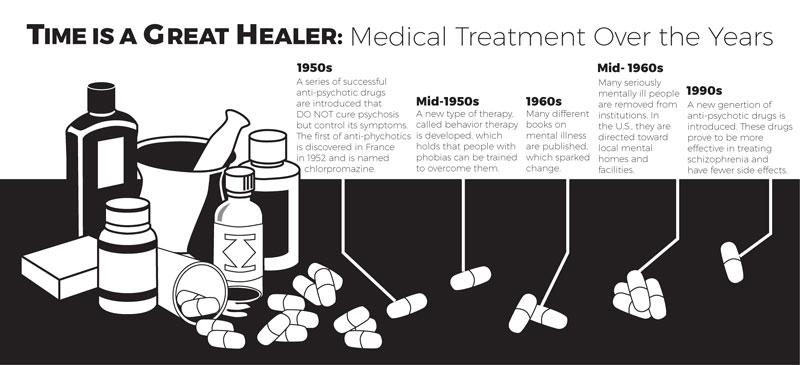Schizophrenics, whom people often portray as psychotic, violent and suicidal individuals with highly unstable lives, are no strangers to society’s ever growing narrative. The symptoms, which include a disconnect to reality via auditory and visual hallucinations, are the perfect features to twist into something disturbing and frightful, an array of traits fit for only the darkest of characters to depict. These stories, however, often only show the grimy and gloomy side of the coin all the while purposefully forgetting the truth of living with schizophrenia.
Recently, researchers at Harvard medical school discovered a genetic link to schizophrenia. The massive study included 28,799 schizophrenics and 35,986 controls. The gene related to schizophrenia is called C4 and is responsible for synaptic pruning (a process where unnecessary neurons and synaptic pathways are eliminated). Excess pruning, which is seen in those who suffer from schizophrenia, causes degradation of the brain, according to medscape.com.
Dr. John Lauriello, the medical director of the University of Missouri Psychiatric Center, said the results of the study don’t come as a surprise to those who follow the field and are just an elegant confirmation of what specialists have been saying for years. Still, Dr. Lauriello believes any research toward both treating schizophrenia and finding more about the genetics related to the disease are beneficial.
“There are a lot of areas [of research] we need to work on at the same time. Better understanding the genetics and other basic science underlying the illness will eventually help us treat or even prevent the illness,” Dr. Lauriello said. “We also have to keep researching better medications and psychosocial treatments for the illness.”
Currently most treatment for schizophrenia consists of therapy and antipsychotic drugs, AP Psychology teacher Rachel Proffit said. Patients are usually diagnosed through a series of interviews with both the patient themself and their family, she added. Although many confuse schizophrenia with dissociative disorder, in reality the two illnesses are completely different, with schizophrenia having a biological basis rather than a cognitive one. Above all, Proffit wants students to know that schizophrenia isn’t understood as clearly as it could be.
“It is a much more common disorder than people think. About one in 100 people will suffer from it. It is important that students understand that, like all disorders, it exists on a spectrum and most patients are not dangerous,” Proffit said. “They also need to know the warning signs, so they can seek help for themselves or a friend if needed.”
Junior Jarrah Crites shares Proffit’s sentiment, as she wants people suffering with schizophrenia to know they aren’t alone. Crites herself first started experiencing auditory hallucinations when she was five years old, but got a clinical diagnosis well after the first symptoms when she was around 15. She said it was hard to tell her family because she felt completely ridiculous.
“I know there are other people who have [schizophrenia], but I felt kind of scared to say anything to anybody about it because in public people [will] call you crazy and they will make fun of you for having it,” Crites said. “I finally told [my parents] because it came to the point where I was inflicting self harm because I thought that it was the right thing to do. [When] I told my parents about it, they suggested that I [get] help, so I went to a psychiatrist and he basically diagnosed me with schizophrenia and bipolar disorder.”
Crites inherited schizophrenia from her mother but has been affected far more than just having the disorder itself. Although Crites no longer lives with her mom, growing up with mental illness has left a lasting impact.
[quote cite=”Rachel Proffit”]The way schizophrenia is portrayed in the media is almost always as a dangerous and/or completely debilitating disorder. In some cases, both of these things are true, but for the most part, it is a treatable disorder.[/quote]
“Because [my mom] had bipolar disorder, schizophrenia, multiple personality disorder and so much other stuff, she was taking a lot of medicine and the medicine would always make her really tired. With her being bipolar and depressed all the time, she would sleep three to four days in a row, just in the bed. I wouldn’t even see her,” Crites said. “Some days she would be up, cleaning the house, cooking a whole bunch of food, buying us stuff, doing whatever. Other times because she was bipolar, she’d get really angry and her and my dad would fight all the time, so it was crazy growing up.”
Medication for schizophrenics is focused around blocking dopamine, a neurotransmitter, and reducing the effect of it on the brain, said Dr. Lauriello. By taking antipsychotic drugs, patients in general are able to think better, however, as with all medications, there are some negative cognitive and physical side effects.
“There really isn’t any psychiatric medications that do not have side effects and the intensity of these side effects can impact whether people will take them. In terms of antipsychotics we have a long list of potential side effects, including stiffness, weight gain and hormonal changes,” Dr. Lauriello said. “The work of the psychiatrist is to help pick medications that work best for each individual with the fewest side effects.”
Even though schizophrenia is widespread and generally treatable, there still continues to be some misconceptions about the disorder, often amplified by the media through horror movies. Common stereotypes include violent tendencies and an inability to be reintegrated into any community. In fact, a study conducted on the matter found that of the majority of schizophrenic main characters in 41 movies released from 1999 to 2010 displayed violent behaviour to either themselves or others.
“The way schizophrenia is portrayed in the media is almost always as a dangerous and/or completely debilitating disorder,” Proffit said. “In some cases, both of these things are true, but for the most part, it is a treatable disorder. If given proper access to medical and psychological care, patients can lead healthy and happy lives, even with the disorder.”
Dr. Lauriello agrees with Proffit and said the misconceptions about schizophrenics aren’t true. He believes schizophrenics have far more in common with the rest of the world than not, something he believes is important to remember as treatment continues to be developed.
“I have seen a steady improvement in our understanding and treatment of schizophrenia in the last 25 years,” Dr. Lauriello said. “I am optimistic that in the next decades we will continue to better understand, treat and possibly prevent this very serious illness.”

Infographic by Stephanie Yang
photo illustration by Grace Vance and Jae Rhee
Categories:
Shattering stereotypes around schizophrenia
April 5, 2016
2
0
Tags:
More to Discover




















































































Siena Juhlin • Apr 14, 2016 at 10:49 pm
The picture used in this is super cool and adds to the story because it shows that something that can be considered “broken” is still beautiful.
Emily Oba • Mar 13, 2016 at 8:51 pm
I don’t know much about schizophrenia and I always thought of it as someone who is crazy and hallucinates but this article changed the way I see schizophrenia. I feel like most people don’t know the real facts on this so there’s a lot of misunderstanding and stereotypes formed.